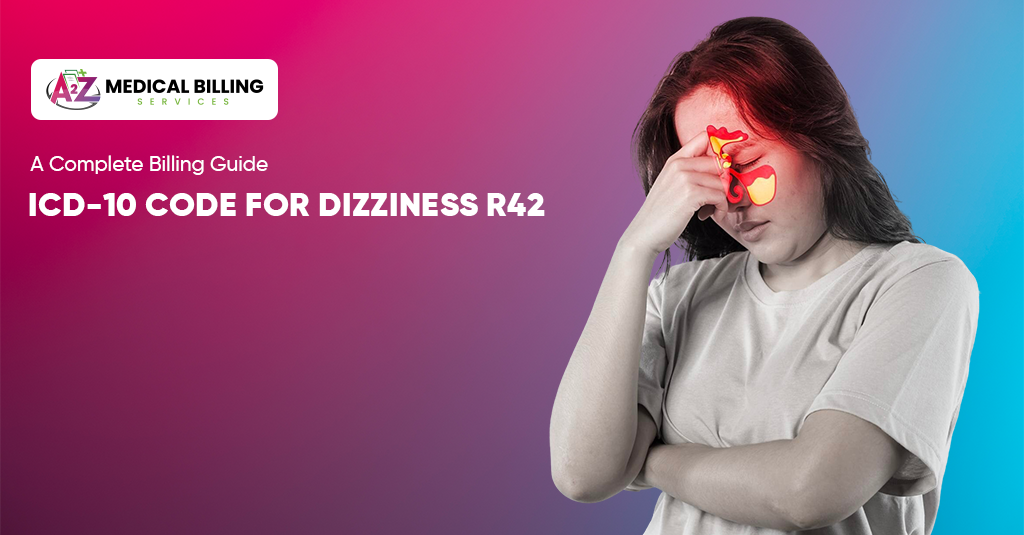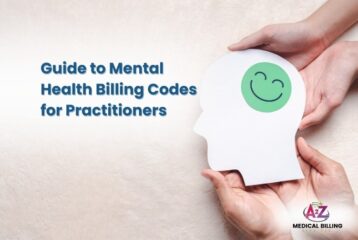When a patient walks in complaining of dizziness, it can mean a dozen different things—from a mild inner ear problem to something as serious as a cardiac or neurological disorder.
But from a billing and coding standpoint, “dizziness” has its own set of rules, codes, and documentation traps that can affect your reimbursement.
Let’s break it down step-by-step so you can correctly use the ICD-10 code for Dizziness R42, avoid denials, and keep your billing clean and compliant.
What is the ICD-10 Code for Dizziness R42?
ICD-10 Code R42 stands for “Dizziness and giddiness.”
It falls under Chapter 18 – Symptoms, signs and abnormal clinical and laboratory findings, not elsewhere classified (R00–R99).
Simply put, R42 is used when the patient presents with dizziness or giddiness, but no definitive cause has been identified yet.
ICD-10 code for Dizziness R42 is a symptom code, not a diagnosis code, which means it should only be used when the cause of dizziness is unknown or under evaluation.
- ICD-10 Code for Dizziness: R42
- Code Description: Dizziness and giddiness
- Billable: Yes (billable/specific code)
- Effective: Since October 1, 2015 (current version 2025 ICD-10-CM)
Clinically, dizziness is a broad symptom that can mean:
- Lightheadedness or feeling faint
- A spinning sensation (vertigo)
- Unsteadiness or loss of balance
- A feeling of floating or swaying
If your patient says, “I feel like the room is spinning,” that’s vertigo (still often billed as R42 if not linked to a specific condition like Meniere’s disease).
If they say, “I feel woozy or about to pass out,” that’s also R42—unless you diagnose something specific like orthostatic hypotension.
Common Conditions of Dizziness

Before you decide to use R42, you’ll often rule out or test for:
- Benign paroxysmal positional vertigo (BPPV) – H81.10 series
- Labyrinthitis or vestibular neuritis – H83.0x
- Meniere’s disease – H81.0x
- Hypotension – I95.x
- Dehydration – E86.0
- Anemia – D50–D64 series
- Cardiac arrhythmias – I49.x
- Medication side effects – T36–T50 with external cause codes
If you find one of these as the definitive cause, code that instead of R42.
If the workup is ongoing or inconclusive, R42 is correct.
When to Use Dazziness ICD 10-R42 as Primary Diagnosis
You can report R42 as the primary diagnosis when:
- The patient’s main reason for the visit is dizziness.
- No underlying cause has been identified during the encounter.
- The workup or referral is being initiated for an evaluation of dizziness.
Example:
A patient visits complaining of intermittent dizziness for two weeks. Exam and labs are normal, and no cause has been determined.
Primary code: R42
When to Use R42 as Secondary Diagnosis
R42 can also serve as a secondary diagnosis if dizziness is a symptom related to another condition.
Example: A patient presents with hypertension (I10) and reports dizziness due to antihypertensive medication.
- Primary code: I10
- Secondary code: R42
- Adverse effect code (if known): T46.4X5A (adverse effect of antihypertensive drugs)
This combination tells the payer both the condition and the symptom.
Average Reimbursement Rate for Dazziness
Reimbursement varies by payer and state, but typical E/M visit payments are linked with R42:
- Medicare (2025 rates): ~$95–$160 for 99213–99214 visits
- Commercial payers: Often pay 15–25% higher, depending on contract rates
- Vestibular tests (92540–92547): Range $70–$180 per test
Billing and Coding Guidelines for ICD-10 Code R42
When you bill for dizziness, you’re walking a fine line between a “symptom visit” and a “diagnostic workup.” Payers want to see that your claim is clinically justified, coded correctly, and backed by clear documentation.
Here’s how to get it right every time.
Use R42 ICD 10 Only When No Definite Cause Is Identified
R42 is a symptom code, not a diagnosis.
That means you should only use it when you haven’t yet identified the underlying cause of the dizziness.
Example:
- Correct: Patient presents with dizziness, unknown cause — use R42.
- Incorrect: Dizziness caused by dehydration — code E86.0 (Dehydration) instead.
If testing later reveals a specific cause (vertigo, anemia, hypotension, etc.), use the corresponding diagnostic ICD-10 code on future claims.
Pair R42 with Proper CPT/HCPCS Codes

Always ensure your CPT or HCPCS codes align with the reason for the visit and reflect the medical necessity for tests performed.
Common CPT Codes Associated with R42:
| CPT Code | Description |
| 99202–99215 | Office/Outpatient E/M Services |
| 92540 | Basic vestibular evaluation, including nystagmus tests |
| 92542 | Positional nystagmus test, each position |
| 93000 | Electrocardiogram (EKG) |
| 36415 | Venipuncture (for labs) |
| 70450 | Head CT (if medically necessary, documented dizziness/neurologic symptoms) |
Tip: Don’t attach R42 to high-cost imaging (CT/MRI) unless your notes explain why dizziness warranted that level of testing (e.g., “sudden onset, possible stroke”).
Ensure Strong Documentation Support
Your documentation should “tell the story” of why the visit or test was necessary.
Payers often deny R42 claims due to vague notes like “Patient dizzy, check labs.”
Include these elements in your chart:
- Chief complaint: “Dizziness for two days”
- Onset and duration: Sudden, gradual, continuous, intermittent
- Associated symptoms: Headache, nausea, chest pain, weakness
- Possible triggers: Standing up, medication, dehydration
- Physical findings: BP readings, nystagmus, neuro exam results
- Clinical reasoning: Why you ordered tests or referred for imaging
Example Note Snippet:
“Patient reports dizziness on standing for 1 week. Denies vertigo or chest pain. Orthostatics stable. No neuro deficits. Likely medication-related. Will review meds and monitor.”
ICD-10: R42
CPT: 99213
Establish Medical Necessity
Every R42 claim must show why the evaluation was clinically reasonable and necessary.
To do this:
- Link R42 to the specific CPT service that addresses dizziness.
- Avoid coding multiple unrelated procedures on the same claim unless properly justified.
- For Medicare, review your local LCD (Local Coverage Determination) to confirm coverage criteria for vestibular or neurodiagnostic testing.
Example: If you bill a vestibular evaluation (92540), documentation should show that dizziness was present, testing was required to assess vestibular function, and the outcome guided treatment or referral.
Use Additional Codes When Appropriate
Sometimes R42 alone doesn’t tell the whole story. Add secondary codes to explain why the patient is dizzy.
Examples:
- R42 + I10: Dizziness with hypertension
- R42 + E86.0: Dizziness due to dehydration
- R42 + T46.4X5A: Dizziness as an adverse effect of antihypertensive drugs
- R42 + R55: Dizziness followed by near-syncope
This combination strengthens your claim and paints a clearer clinical picture.
Ensure Correct Modifier Usage
If you perform multiple unrelated services during the same visit, use modifiers to separate them correctly.
- Modifier 25: Use when you perform a significant, separately identifiable E/M service along with a procedure (e.g., dizziness evaluation + ear irrigation).
- Modifier 59: Use to distinguish procedures that are not commonly reported together but were appropriate in that encounter.
Always confirm payer-specific modifier rules.
Payer and Coverage Guidelines
Medicare:
- Accepts R42 as a valid code for dizziness evaluation if documentation supports diagnostic necessity.
- It often requires a secondary diagnosis when billing for vestibular or neurologic testing.
- Denies coverage if testing appears routine or screening-level.
Medicaid:
- Varies by state; check individual program manuals.
- A clear link between the symptom and the service performed is required.
Commercial Insurers (Aetna, BCBS, UHC, Cigna):
- Typically, follow Medicare logic.
- May require pre-authorization for expensive imaging (CT/MRI).
- Denials often occur when documentation is vague or generic.
Dazziness ICD-10 Code Sequencing
If dizziness is the chief complaint, list R42 as primary.
If it’s secondary to another diagnosis, list R42 after the main condition.
Example:
- Primary: H81.13 (BPPV, bilateral)
- Secondary: R42 (Dizziness symptom)
This sequencing ensures clarity and supports medical necessity in multi-symptom visits.
Compliance and Audit Readiness
Auditors often review R42 cases because dizziness can overlap with cardiac, vestibular, and neurological conditions.
Keep your records ready by:
- Documenting each visit thoroughly.
- Including test results and interpretation.
- Updating diagnosis when a cause is identified.
- Linking every test and charge to the symptom that justified it.
Conclusion
Patients might describe dizziness a dozen ways, but payers only understand it one way: through your documentation and code choice.
Treat R42 as your “temporary placeholder” until you know what’s behind the dizziness — and you’ll avoid the headaches that come with vague coding.
R42 is a simple code with complex billing implications. When used correctly, it accurately captures a common patient complaint and supports proper reimbursement. When misused, it triggers denials and audits.
So — when in doubt, document well, justify your tests, and always choose the most specific code available.
Stop Spinning Your Wheels On Rejected Claims
If billing for dizziness feels like a never-ending balancing act, you’re not alone. ICD-10 code R42 may look simple, but one vague note or mismatched CPT code can send your claim straight to denial land. That’s where we come in.
A2Z Billing handles your dizziness-related billing from A to Z — verifying coverage, coding with precision, fixing documentation gaps, and following through until payment hits your account. Our team doesn’t just submit claims; we turn every R42 visit into real revenue while keeping your compliance airtight. Let’s steady your cash flow instead.
Schedule A Free Billing Audit Or Consultation Today



